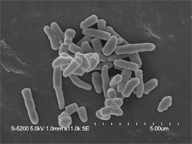Rhodococcus erythropolis PR4 (= NBRC 100887)
The genus Rhodococcus is a diverse group of bacteria commonly found in many environments from soil to seawater. They are Gram-positive, high G+C content, coryneform bacteria belonging to the order Actinomycetales. Many strains of Rhodococcus bacteria show remarkable metabolic versatility, including their ability to degrade a variety of xenobiotic compounds such as polychlorinated biphenyls (PCBs). Some strains are known to produce biosurfactants and still others are source of useful enzymes such as phenylalanine dehydrogenase and endoglycosidases. Because of these characteristics, Rhodococcus bacteria are assumed to be industrially important.
Rhodococcus erythropolis PR4 (= NBRC 100887) has been isolated from the deep sea at a depth of 1,000 m in south of Okinawa Island, Japan (the Pacific Ocean)[1]. This strain can utilize n-alkanes of C8 to C20, alkylbenzenes, and pristine (2,6,10,14-tetramethylpentadecane) as sources of carbon and energy[1, 3]. It can also produce a large quantity of extracellular polysaccharides (EPSs), which are assumed to play a crucial role in its tolerance to a variety of organic solvents[4, 5, 6].
The complete genome consisted of one circular chromosome (6,516,310 bp; GC content 62.31%), one linear plasmid (pREL1: 271,577 bp), and two circular plasmids (pREC1: 104,014 bp; and pREC2: 3,637 bp). A total of 6,437 ORFs were predicted on the chromosome and three plasmids. The chromosome and linear plasmid encode many genes involved in the degradation of alkanes. In addition, genes responsible for the degradation of intermediates in the catabolism of aromatic compounds, such as protocatechuic acid and catechol, are clustered on the chromosome. The genome also contains a number of genes for secondary metabolism and EPS biosynthesis.
This work was supported by the New Energy and Industrial Technology Development Organization (NEDO).

Photo by
Dr. Otoguro, Dr. Tamura (NBRC, NITE)
References:
- [1] Construction of bacterial consortia that degrade Arabian light crude oil.
- Komukai-Nakamura, S., Sugiura, K., Yamauchi-Inomata, Y., Toki, H., Vankateswaran, K., Yamamoto, S., Tanaka, H., Harayama, S. (1996)
J Ferment Bioeng. 82(6):570-574. - [2] Sequence analysis of three plasmids harboured in Rhodococcus erythropolis strain PR4.
- Sekine, M., Tanikawa, S., Omata, S., Saito, M., Fujisawa, T., Tsukatani, N., Tajima, T., Sekigawa, T., Kosugi, H., Matsuo, Y., Nishiko, R., Imamura, K., Ito, M., Narita, H., Tago, S., Fujita, N., Harayama, S. (2006)
Environ Microbiol. 8(2):334-46. [PMID:16423019] - [3] Characterization of four Rhodococcus alcohol dehydrogenase genes responsible for the oxidation of aromatic alcohols.
- Peng, X., Taki, H., Komukai, S., Sekine, M., Kanoh, K., Kasai, H., Choi, SK., Omata, S., Tanikawa, S., Harayama, S., Misawa, N. (2006)
Appl Microbiol Biotechnol. 71(6):824-32. [PMID:16292529] - [4] Structural analysis of mucoidan, an acidic extracellular polysaccharide produced by a pristane-assimilating marine bacterium, Rhodococcus erythropolis PR4.
- Urai, M., Yoshizaki, H., Anzai, H., Ogihara, J., Iwabuchi, N., Harayama, S., Sunairi, M., Nakajima, M. (2007)
Carbohydr Res. 21;342(7):927-32. [PMID:17316584] - [5] Structural analysis of an acidic, fatty acid ester-bonded extracellular polysaccharide produced by a pristane-assimilating marine bacterium, Rhodococcus erythropolis PR4.
- Urai, M., Yoshizaki, H., Anzai, H., Ogihara, J., Iwabuchi, N., Harayama, S., Sunairi, M., Nakajima, M. (2007)
Carbohydr Res. 21;342(7):933-42. [PMID:17316581] - [6] A comparison of various methods to predict bacterial predilection for organic solvents used as reaction media.
- Hamada, T., Sameshima, Y., Honda, K., Omasa, T., Kato, J., Ohtake, H. (2008)
J Biosci Bioeng. 106(4):357-62. [PMID:19000611]
| chromosome | pREL1 | pREC1 | pREC2 | TOTAL | |
|---|---|---|---|---|---|
| Genomic size (bps) | 6,516,310 | 271,577 | 104,014 | 3,637 | 6,895,538 |
| The number of ORFs | 6,034 | 298 | 102 | 3 | 6,437 |
| GC content (%) | 62.3 | 61.9 | 63.0 | 62.2 | |
| Genome Database | DOGAN | ||||
| NBRC* No. : | 100887 | ||||
- *:
- NBRC is the acronym for "the NITE Biological Resource Center".
The URL of NBRC is http://www.nbrc.nite.go.jp/e/index.html.
- Distribution of Our Microbial Genomic DNAs
- At the Biological Resource Center of the National Institute of Technology and Evaluation (NITE Biological Resource Center, an Incorporated Administrative Agency), we have been distributing the microbial genomic DNA.
Contact us
- Biotechnology Evaluation and Development Division, Biological Resource Center, National Institute of Technology and Evaluation
-
Address:2-49-10 Nishihara, Shibuya-ku, Tokyo 1510066, Japan MAP
Contact Form


